CARD TRICKS [DAY 3]
ADDITION STRATEGY: ADD EXTRA AND ADJUST
Dive into this 5-Day Problem Based Math Unit which focused on the efficient strategy of adding extra and adjusting using numbers within 50
Intentionality
Spark Curiosity
Fuel Sensemaking
During Moves
Student Approaches
Next Moves
Consolidation
Reflect and Consolidation Prompts
Resources & Downloads
Educator Discussion Area
Intentionality & Unit Overview
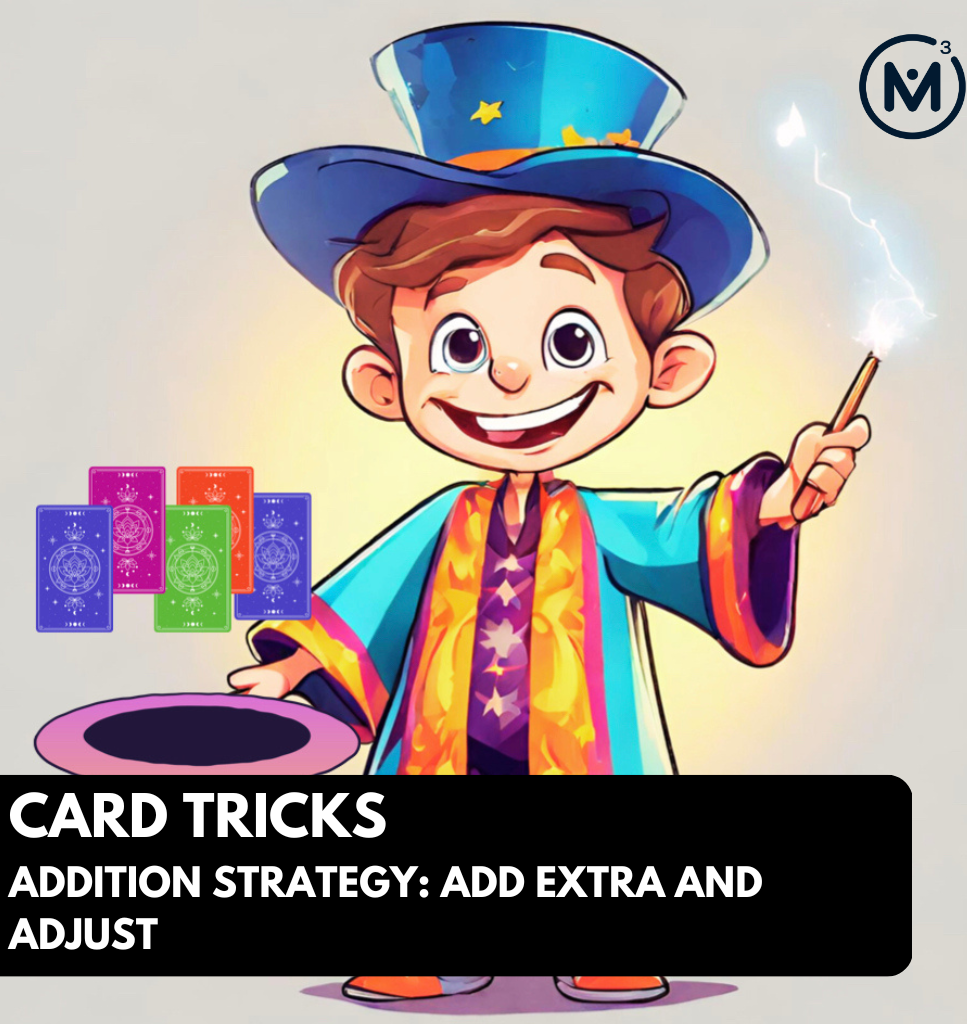
Length of Unit: 5 Days
Access each lesson from this unit using the navigation links below
Students will explore addition in a context encouraging students to use a strategy that allows them to flexibly work with one addend by rounding it to the nearest decade then adjusting after to efficiently add numbers within 50
Intentionality…
In this task, students will engage in an addition context and lead towards the “Add extra and adjust” strategy.
Some of the big ideas that may emerge through this task include:
- Understanding hierarchical inclusion allows for flexible composing and decomposing of numbers
- Numbers can be decomposed by separating a whole into two or more parts
- Addition names the whole in terms of the parts
- Different addition situations will elicit different strategies
- Number relationships provide the foundation for strategies to help students remember basic facts
- Models can be used to connect concrete to abstract
Before starting this unit, students should be familiar with:
- Rounding numbers
- Adding decade numbers
- Subtracting near numbers
Spark Curiosity
What Do You Notice? What Do You Wonder?
Show students the following video:
Then, ask students:
What do you notice?
What do you wonder?
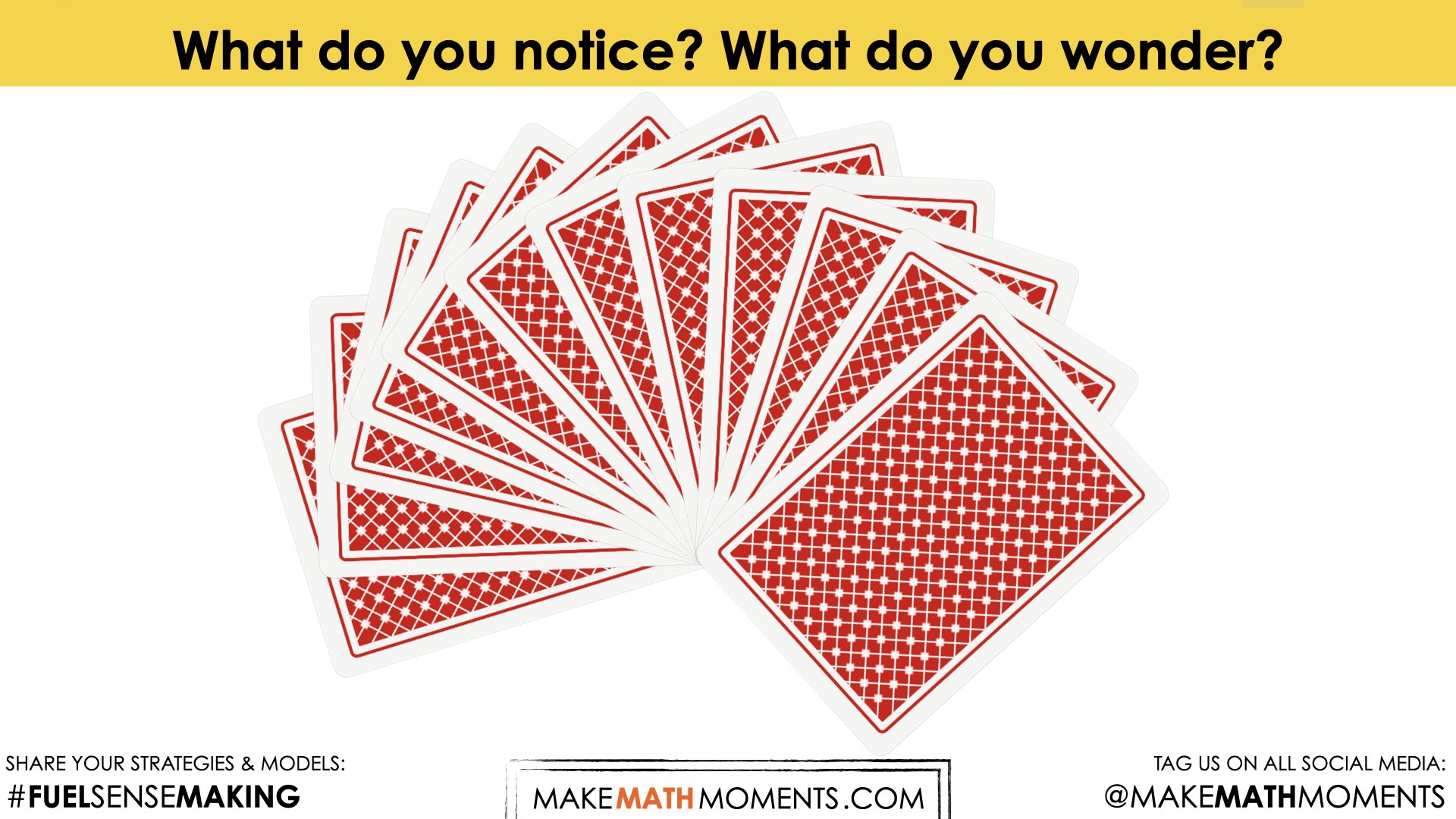
Give students about 30-60 seconds to do a rapid write on a piece of paper or silent individual think time.
Replaying the video can be helpful here if appropriate. Ensure that students do not long enough to 1:1 count each card. This will encourage some subitizing to occur and for students to visual what they saw.
Then, ask students to pair share with their neighbors for another 60 seconds.
Finally, allow students to individually share with the entire group. Be sure to write down these noticings and wonderings on the blackboard/whiteboard, chart paper, or some other way that is visible to all. This helps students to see the thinking of their classmates and ensures each student that their voice is acknowledged and appreciated. Adding student names or initials next to their notice/wonder is one way to acknowledge their participation and can motivate others to join in.
Some of the noticing and wondering may include:
- I notice that there is a deck of cards
- I notice that the cards are red
- I wonder if they are going to play a card game
- I wonder if they are going to do a card trick
Estimation: Prompt
After we have heard students and demonstrated that we value their voice, we can ask the estimation question. The students may have already made some guesses of the amount of ants in the previous section. The students will feel valued as you now ask them to make a true estimation.
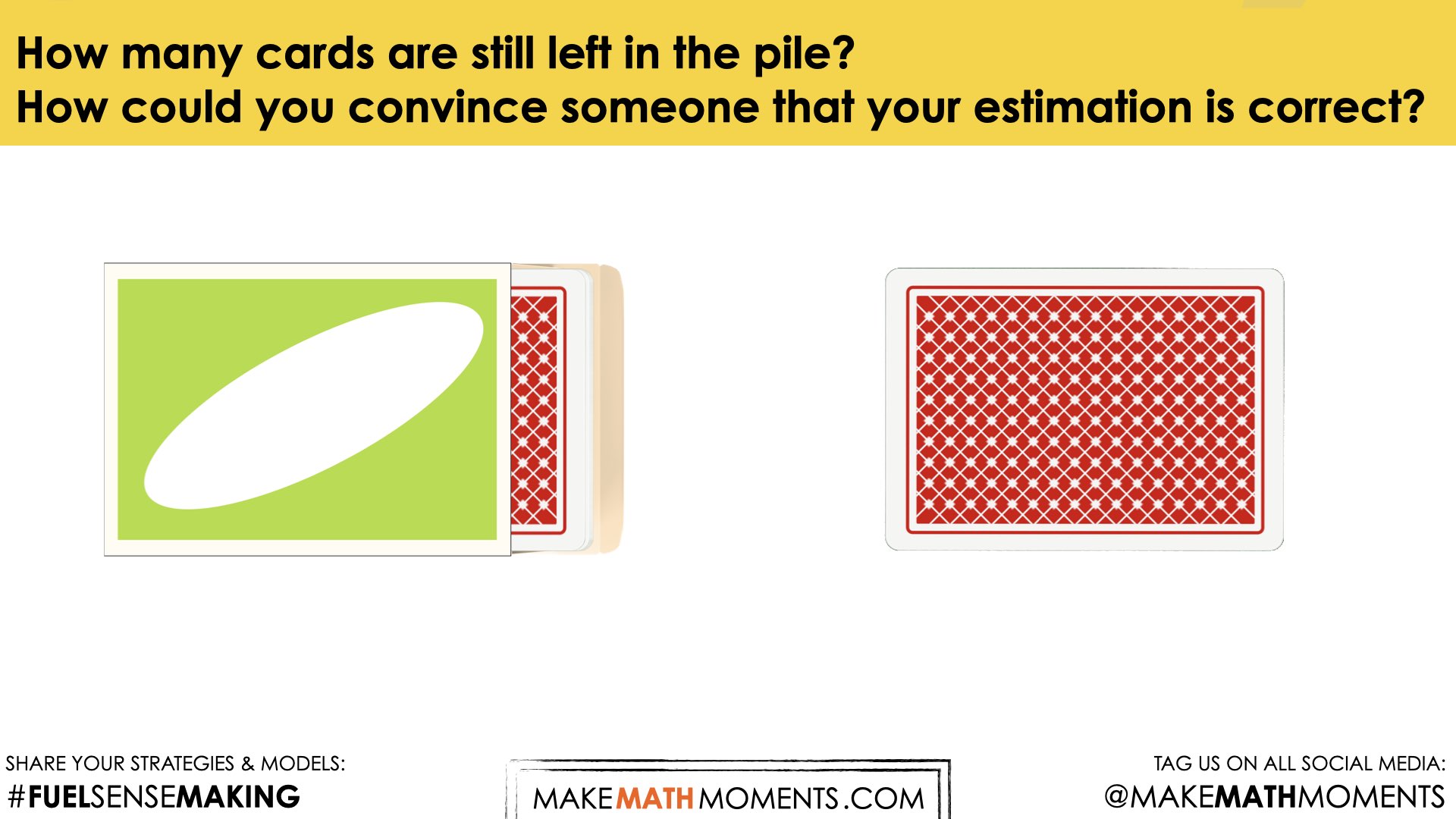
How many cards are still left in the pile?
Follow up that question with:
How could you convince someone that your estimation is correct?
It may be important to inform students that a typical deck of cards has 52 cards in it. This may help them determine a more accurate estimation.
We can now ask students to make an estimate (not a guess) as we want them to be as strategic as they can possibly be. Before collecting student estimates, students can share their estimates with neighbouring students along with the reasonings.
Consider asking students to think about a number that would be “too low” and a number that would be “too high” before asking for their best estimate in order to help them come up with a more reasonable estimate.
While Students are Estimating:
Monitor student thinking by circulating around the room and listening to the mathematical discourse. You may identify some students whose thinking would be valuable to share when the group’s estimates are collected.
Similar to collecting their noticings and wonderings, collect students’ range of estimates and/or best estimates along with initials or names. Having some students share justifications is an opportunity for rich, mathematical discourse.
Estimation: Reveal
Login/Join to access the entire Visual Prompt, downloadable slide decks and printable handouts for this lesson and all problem based units.
Fuel Sense-making
Crafting A Productive Struggle: Prompt
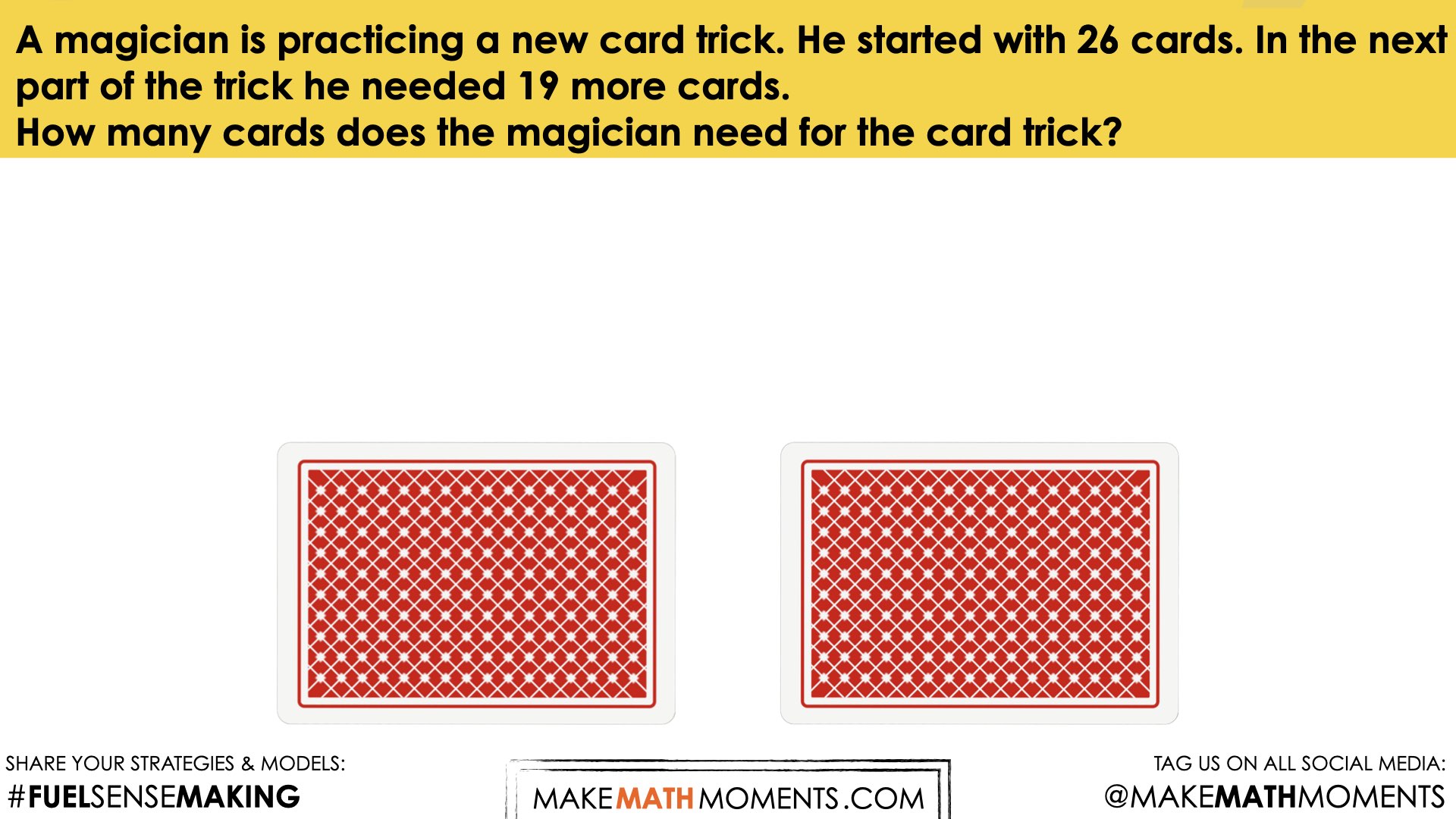
Here we are asking students to envision a solution path. By considering what information will be needed and how it can be used to solve the problem, students are being asked to make sense of the problem and reason abstractly and quantitatively. By not simply providing this information, we are inducing students to engage more deeply with the problem and think about all of its parts, known and unknown, before they begin crunching the numbers.
During Moves
While Students Are Productively Struggling…
Login/Join to access the entire Visual Prompt, downloadable slide decks and printable handouts for this lesson and all problem based units.
Student Approaches
Student Approach #1: Counting All with a Drawing
Login/Join to access the entire Visual Prompt, downloadable slide decks and printable handouts for this lesson and all problem based units.
Student Approach #2: Counting On
Login/Join to access the entire Visual Prompt, downloadable slide decks and printable handouts for this lesson and all problem based units.
Student Approach #3: Algorithm
Login/Join to access the entire Visual Prompt, downloadable slide decks and printable handouts for this lesson and all problem based units.
Student Approach #4: Efficiently Break Apart One Number
Login/Join to access the entire Visual Prompt, downloadable slide decks and printable handouts for this lesson and all problem based units.
Student Approach #5: Add Extra and Adjust
Login/Join to access the entire Visual Prompt, downloadable slide decks and printable handouts for this lesson and all problem based units.
Next Moves
Reveal
Show students the following reveal video:
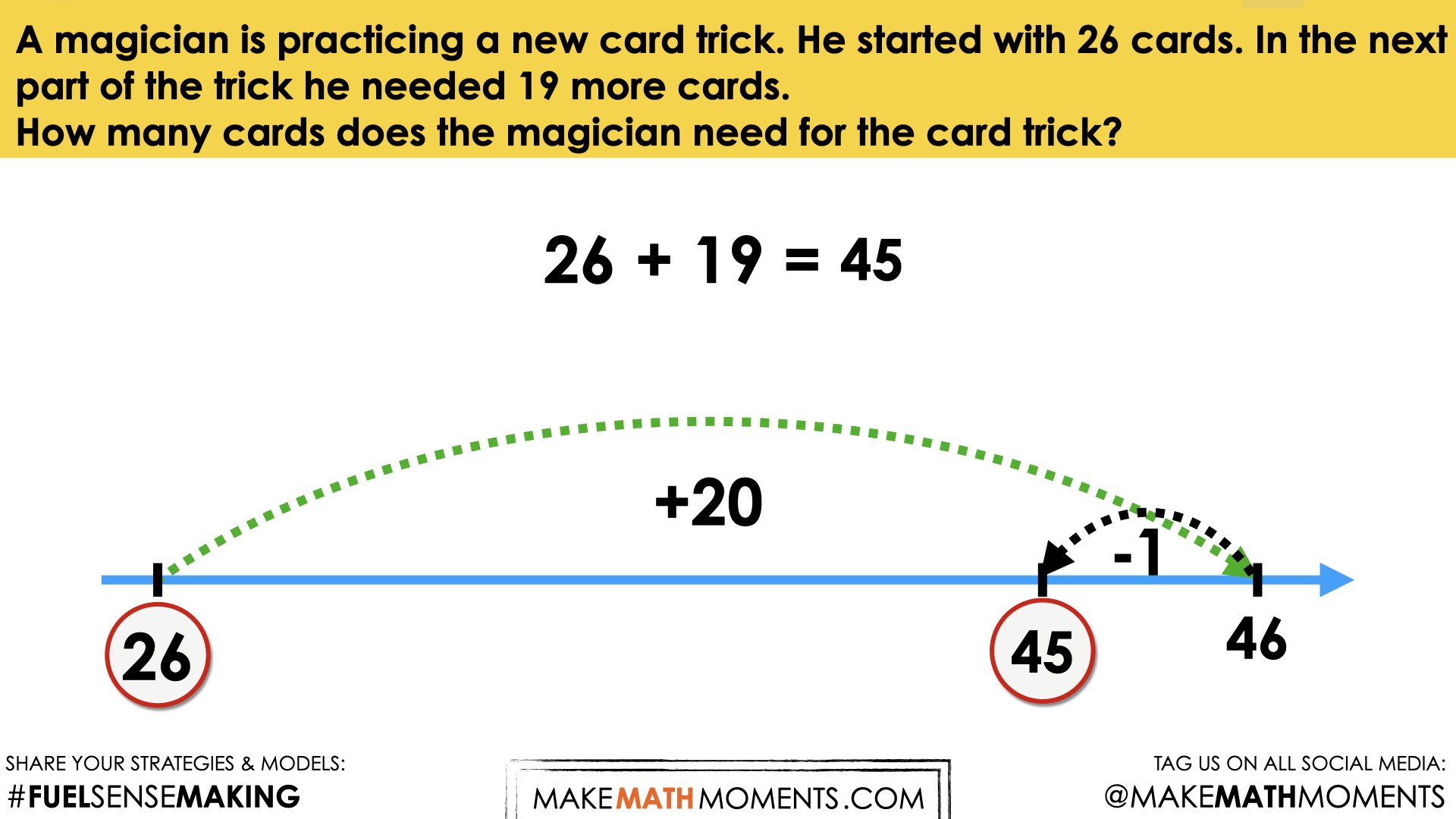
Consolidation
Login/Join to access the entire Visual Prompt, downloadable slide decks and printable handouts for this lesson and all problem based units.
Reflect and Consolidation Prompts
Login/Join to access the entire Visual Prompt, downloadable slide decks and printable handouts for this lesson and all problem based units.
Resources & Downloads
Login/Join to access the entire Visual Prompt, downloadable slide decks and printable handouts for this lesson and all problem based units.
Printable Lesson Plan PDF
Videos, Images & Media Files
Apple Keynote Presentation
Powerpoint Presentation
Printable Consolidation Prompts
Educator Discussion Area
Login/Join to access the entire Teacher Guide, downloadable slide decks and printable handouts for this lesson and all problem based units.
Explore Our 60+ Problem Based Units
This Make Math Moments Lesson was designed to spark curiosity for a multi-day unit of study with built in purposeful practice, number talks and extensions to elicit and emerge strategies and mathematical models.
Dig into our other units of study and view by concept continuum, grade or topic!


